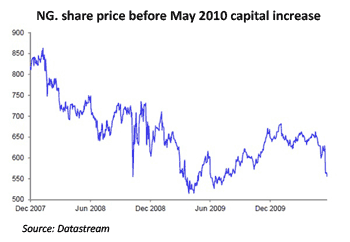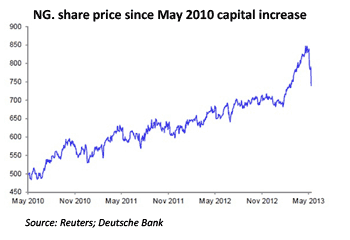Should I buy shares in National Grid?
11th June 2013 16:19
by Darshini Shah from interactive investor
Share on
After rallying 50% since 2010, shares in have slipped 10% over the past month, prompting investors to look at this perceived safe haven once again.
National Grid owns regulated electricity and gas transmission and distribution networks in the UK and US. These networks are statutory monopolies and therefore face controls on prices determined by independent regulators.
A history lesson
The share price has seen its fair share of ups and downs over the past five years.

National Grid was trading at well over 800p a share at the end of 2007, but suffered in the following two years from a combination of macroeconomic financial concerns and company-specific worries.
During 2008, the stock suffered along with global equity markets more generally, including an extreme one-day move on 10 October 2008 as global equity markets were marked down on concerns about the US political response to financial companies' balance-sheet problems.
Although equity markets recovered in the second half of 2009, concerns about National Grid's financial outlook somewhat clouded the share-price recovery.
Three key issues prompted the stock's decline. Firstly, investors were concerned about returns from the US business, which were suffering from fixed unit prices and rising unit costs. There were also worries about UK cash flow and investment as well as the company's balance sheet and dividends.

US return "broadly sustainable"
From its entry into the US in 1998 through to 2004, National Grid pursued a strategy of agreeing to fixed-price deals with state regulators in the hope of cutting unit costs and keeping a share of the outperformance. This was generally in contrast to traditional US rate of return regulation where rate cases were more frequent, reducing risk but also limiting opportunity for returns well above the base allowed level.
Lower-than-expected demand growth, combined with rising costs (including pensions and health care), and increased investment requirements drove unit costs higher. US returns suffered as a result of the fixed-price deals.
However, as multi-year, fixed-price rate agreements in the US came to an end, National Grid made progress in securing rate increases to cover costs. In fact, by the agreement of the major Niagara Mohawk electricity distribution rate settlement in January 2011, National Grid had secured $388 million (£248 million) of rate increases since late 2008.
In addition to securing revenue increases, the rate cases also reduced the risks around future returns through changes in the price control mechanisms. These included revenue decoupling, which allowed the businesses to recover a fixed amount of revenue regardless of the actual level of demand for gas or electricity in the year; capital trackers, which allowed for automatic increases in revenues as elements of capital costs rise; and finally, an allowance for bad debts, linked to movements in commodity prices.
"This will not always be a positive driver given the low US gas and power wholesale prices resulting from the impact of shale gas, but it should track actual bad debt costs more closely than the previous fixed allowances," points out Martin Brough, analyst at Deutsche Bank.
In addition to progress on rate cases, National Grid has stepped up its cost-cutting efforts in the US in the last few years. For instance, in January 2011, the utility firm announced a restructuring and efficiency programme. The group moved from global business lines to a regional model, accompanied by a $200 million US efficiency programme, cutting 1,200 US positions.
The combination of rate cases and cost reductions has had a positive impact on achieved returns in key US regulated networks. Brough expects the current returns to be broadly sustainable for these networks.
The US gas and electricity division accounts for about quarter of National Grid's enterprise value.
Regulator assists UK operations
In the UK, the regulated businesses were generally performing well, but there were some concerns about the outlook for cash flows due to rising investment plans.
For example, in October 2008, National Grid announced a step-up in group capital expenditure from about £2.7 billion per annum to around £3 billion per annum. "This timing was unfortunate given the global concerns at the time about balance sheets and debt funding," notes Brough.
National Grid's estimated group capital expenditure was increased again, from £3 billion per annum to around £4.4 billion per annum, in May 2010, when the £3.2 billion capital increase was announced.
But it wasn't just the rise in capital expenditure that spooked investors. There was also a growing risk from regulator Ofgem that cash depreciation rates on the existing regulatory asset base (RAB) could be cut. In the run-up to the new RIIO (Revenue = Incentives + Innovation + Outputs) price controls, Ofgem highlighted that the estimated useful lives of the UK electricity and gas networks were much longer than the payback periods implied by current levels of cash depreciation on the RABs.
The regulator also discussed eliminating the 50% up-front cash allowance for gas distribution replacement spending, which would have further squeezed group cash flows.
Finally, there was some uncertainty about the allowed rates of return on the new investment, given Ofgem's introduction of a new regulatory framework under RIIO.
However, in the last three years, National Grid has made progress in reassuring investors about future returns from its UK business.
The regulator helped too - in December 2010, Ofgem had suggested a range for the future allowed real, post-tax return on equity of between 4.0% and 7.2%. By March 2011, Ofgem had narrowed the range to between 6.0% and 7.2%, eliminating the bottom end of the range.
On a qualitative basis, the regulatory tone has also generally been positive. In particular, Ofgem chief executive Alistair Buchanan has, on a number of occasions, publicly remarked that companies performing well should be given the opportunity to make "double-digit" returns, i.e. a real post-tax return on regulated equity of over 10%.
The UK transmission and gas distribution businesses account for around 70% of National Grid's enterprise value.
No balance sheet worries
In addition to concerns over the US and UK regulated businesses, investors were worried about the robustness of National Grid's group finances. Many UK utilities increased their gearing to more "efficient" levels from 2005 to 2007. Transactions were generally under highly-leveraged structures while the listed utility firms took advantage of cheap debt and loosening requirements from credit rating agencies.
National Grid also shifted more towards debt finance over this period. Following the acquisition of the US Keyspan business, it disposed of non-core operations and returned cash to shareholders through a buyback. It also increased its dividend significantly.
National Grid had a group target of maintaining its 'A' credit rating. However, in January 2008, Moody's changed the outlook on National Grid and its subsidiaries from stable to negative, citing a 15% increase in the dividend at the time as a relevant factor. As the global financial crisis receded somewhat, in July 2009, Moody's revised the outlook back to stable.
Despite the more optimistic outlook, many investors were still concerned about the ability of the group to fund more capital expenditure while preserving the dividend.
"The remaining uncertainties around success in future US rate cases, and the cash flows under the new UK RIIO framework also contributed to investor unease," Deutsche Bank's Brough says. "Against this backdrop, the capital increase in May 2010 was seen by some as more to do with balance sheet repair than a way of funding value-enhancing UK growth."
However, over the last five years, the cost of debt has fallen in both real and nominal terms and utility companies have taken advantage of the opportunity to issue hybrid capital.
"The capital increase, the falling cost of debt, availability of hybrid finance and rising retail price inflation (RPI), together with the progress on US and UK regulation led to National Grid issuing its new dividend policy of growing the dividend at least in line with RPI for the foreseeable future," Brough adds.
Dividend policy
One of the key attractions of National Grid is its 5.7% prospective dividend yield and promise to grow the divided at least in line with RPI inflation for the foreseeable future.
However, Brough points out: "National Grid's dividend represents a payout of 11.4% on its regulated equity value, compared with only 6.5% for , which makes us cautious on its sustainability."
He doesn't believe National Grid is earning enough to pay the dividend in cash while growing its real regulated equity value per share, commenting: "With a dividend of over 10% of regulated equity, National Grid needs to keep on making double-digit real returns beyond the present price controls for the income to be sustainable.
"This looks optimistic to us."
Valuation
National Grid does not look expensive, trading on a 2013 price/earnings ratio of about 14 times, a valuation Brough says is "attractive" when compared to United Utilities, or US-listed utilities.
Next catalyst
National Grid is hosting an investor day on 5 August.
Conclusion
"National Grid is inherently a low-risk business, with regulated electricity and gas networks in the UK and the US. New price controls agreed with regulators will allow the company to earn an after-tax return on regulated equity of about 10% in real terms," Brough states.
He adds: "With a generally benign political situation (at least for the regulated networks) and with the UK price reviews secured for the next eight years, there is much less risk around earnings for National Grid than for the German, French, Spanish or Italian utilities."
Still, he rates the stock a 'sell', explaining: "After the very strong increase the share price has seen since the 2010 capital increase, we find the returns on offer at the current share price unattractive, with the dividend part-funded through scrip and growing leverage in our view."
This article is for information and discussion purposes only and does not form a recommendation to invest or otherwise. The value of an investment may fall. The investments referred to in this article may not be suitable for all investors, and if in doubt, an investor should seek advice from a qualified investment adviser.